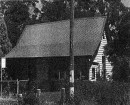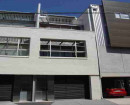Back to search results
PRIMARY SCHOOL NO. 2120
17 JACKSON STREET LONG GULLY, GREATER BENDIGO CITY
PRIMARY SCHOOL NO. 2120
17 JACKSON STREET LONG GULLY, GREATER BENDIGO CITY
All information on this page is maintained by Heritage Victoria.
Click below for their website and contact details.
Victorian Heritage Register
-
Add to tour
You must log in to do that.
-
Share
-
Shortlist place
You must log in to do that.
- Download report

PRIMARY SCHOOL NO. 2120 SOHE 2008






On this page:
Statement of Significance
Long Gully Primary School, constructed in 1879, is significant as a particularly good representative example of the work of Henry Bastow in response to climatic conditions.
The School demonstrates a new solution to user requirements, and also as an essentially intact example of a building type. It is also a notable creative accomplishment in the history of architecture in Victoria.
Long Gully Primary School is significant as an example of high quality craftsmanship in building construction and use of materials.
Show more
Show less
-
-
PRIMARY SCHOOL NO. 2120 - Permit Exemptions
General Exemptions:General exemptions apply to all places and objects included in the Victorian Heritage Register (VHR). General exemptions have been designed to allow everyday activities, maintenance and changes to your property, which don’t harm its cultural heritage significance, to proceed without the need to obtain approvals under the Heritage Act 2017.Places of worship: In some circumstances, you can alter a place of worship to accommodate religious practices without a permit, but you must notify the Executive Director of Heritage Victoria before you start the works or activities at least 20 business days before the works or activities are to commence.Subdivision/consolidation: Permit exemptions exist for some subdivisions and consolidations. If the subdivision or consolidation is in accordance with a planning permit granted under Part 4 of the Planning and Environment Act 1987 and the application for the planning permit was referred to the Executive Director of Heritage Victoria as a determining referral authority, a permit is not required.Specific exemptions may also apply to your registered place or object. If applicable, these are listed below. Specific exemptions are tailored to the conservation and management needs of an individual registered place or object and set out works and activities that are exempt from the requirements of a permit. Specific exemptions prevail if they conflict with general exemptions. Find out more about heritage permit exemptions here.Specific Exemptions:Public Safety and Security- All works required to maintain, secure and make safe buildings and structures such as the removal of broken glass, the temporary shuttering of windows and covering of holes providing this work is reversible and does not have a detrimental impact on fabric.
- Erection of temporary fencing necessary to maintain public safety to be limited to a period of 6 months.
- Works or activities, including emergency stabilisation, necessary to secure safety in an emergency where a structure or part of a structure has been irreparably damaged or destabilised and poses a safety risk to its users or the public. It is acknowledged that in some instances additional damage to significant fabric may be required to stabilise and make safe. In these instances every attempt must be made to conserve and retain as much significant fabric as possible. The Executive Director, Heritage Victoria, must be notified within seven days of the commencement of these works or activities.
Garden and landscape- Subsurface works involving the installation, removal or replacement of watering and drainage systems or other services provided there are no visible above ground elements. Landscaping, paving etc. is to be returned like for like on the completion of works.
- The processes of gardening, including mowing, hedge clipping, bedding displays, disease and weed control, maintenance of existing plants and replacement with similar species.
- The removal or pruning of dead or dangerous trees to maintain safety.
- Management and maintenance of trees including formative and remedial pruning, removal of deadwood, pest and disease control, cabling and similar supportive works.
- Like for like repair and maintenance of existing hard landscaping including paving, footpaths and driveways.
- Removal of later addition paving, paths, stairs and garden walls.
- Works associated with the management of possums or vermin.
- Clearing and maintenance of drains and gutters.
Buildings and features of primary heritage significance.
These works can be carried out without a permit provided they do not cause harm to the cultural heritage significance of the place:
Exteriors- Removal, replacement or works to recently installed services and structures such as fire services, bollards, lighting and security devices etc, provided the location and scale remains the same.
- Maintenance, repair and replacement of existing external services such as plumbing, electrical cabling, surveillance systems, pipes or fire services which does not involve changes in location or scale.
- Repair to, or removal of items such as antennae; aerials; and air conditioners and associated pipe work, ducting and wiring.
- Painting of previously painted surfaces in the same colour, finish and type provided that preparation or painting does not remove earlier paint finishes or other decorative schemes.
- Installation or repair of damp-proofing in a manner which does not harm significant fabric.
- Minor patching, repair and maintenance which replaces like with like without large-scale removal of or damage to the existing fabric or the large-scale introduction of new materials. Repairs must maximise protection and retention of fabric and include the conservation of existing details or elements. Any new materials used for repair must not exacerbate the decay of existing fabric due to chemical incompatibility, obscure existing fabric or limit access to existing fabric for future maintenance.
- Removal or replacement of existing external fixed and non-illuminated signage provided the size, location and material remains the same.
Interiors- Painting of previously painted walls, ceilings and other elements in the same colour, finish and type provided that preparation or painting does not remove evidence of earlier paint or other decorative schemes. No stained timberwork is to be painted. This exemption does not apply to areas where there are specialist paint techniques such as graining, marbling, stencilling, hand-painting, murals or signwriting, or to wallpapered surfaces, or to unpainted, oiled or varnished surfaces.
- Removal of paint from originally unpainted or oiled surfaces including ceilings, joinery, doors, architraves and skirtings by non-abrasive methods.
- Installation, removal or replacement of safety devices such as detectors, alarms, emergency lights, exit signs, luminaires and the like.
- Installation, removal or replacement of carpets and/or flexible floor coverings, window dressings, and devices for mounting artworks and noticeboards.
- Minor patching, repair and maintenance which replaces like with like without large-scale removal of or damage to the existing fabric or the large-scale introduction of new materials. Repairs must maximise protection and retention of fabric and include the conservation of existing details or elements. Any new materials used for repair must not exacerbate the decay of existing fabric due to chemical incompatibility, obscure existing fabric or limit access to existing fabric for future maintenance.
- Demolition or removal of the following post-1970s items: stud/partition walls, suspended ceilings or wall linings (including plasterboard, laminate and Masonite), flush panel or part-glazed laminated doors, lights and light fittings, built-in cupboards, cubicle partitions, computer and office fitouts and the like.
- Installation, removal or replacement of ducted, hydronic or concealed radiant type heating provided that the installation does not damage existing skirtings and architraves, and provided that the central plant is concealed, and that the work is done in a manner which does not harm the cultural heritage significance of the place.
- Works to maintain or refurbish existing post-1970s bathrooms and toilets, including installing new appliances, retiling and the like.
- Replacement of existing services such as cabling, plumbing, electrical wiring and fire services that uses existing routes, conduits or voids, and does not involve damage to or the removal of significant fabric.
- Works to maintain or refurbish existing kitchen and hospitality facilities including installing new appliances and floor coverings.
- Installation, removal or replacement of electrical and IT wiring provided that such works do not require chasing or cutting into significant fabric and providing that any early light switches, light fittings, pull cords, push buttons or power outlets are retained in-situ. Note: if wiring original to the place was carried in timber conduits then the conduits and unused original wiring should remain in situ.
- Installation of plant within the roof space, providing that it does not impact on the external appearance of the building or involve structural changes.
- Installation, removal or replacement of bulk insulation in the roof space.
- Installation, removal or replacement of smoke detectors.
Buildings of no heritage significance (modern portable toilet block, classrooms and canteen)
Exteriors
All the permit exemptions for buildings and features of primary significance and also:- Demolition and removal of the modern portable toilet block, classrooms and canteen where they are freestanding and do not intersect with buildings of primary heritage significance provided a report and plans showing adequate protection for the buildings of primary significance is first approved by the Executive Director.
- Note: a permit is required for new buildings that will replace buildings that have been demolished or relocated.
Interiors- All works.
-
-
-
-
-
DERBY MINE
 Victorian Heritage Inventory
Victorian Heritage Inventory -
WINDMILL HILL SHAFT
 Victorian Heritage Inventory
Victorian Heritage Inventory -
CARLISLE SHAFT
 Victorian Heritage Inventory
Victorian Heritage Inventory
-
177 Fenwick Street
 Yarra City
Yarra City -
19 Cambridge Street
 Yarra City
Yarra City -
2 Derby Street
 Yarra City
Yarra City
-
-









